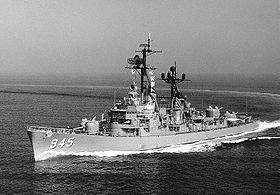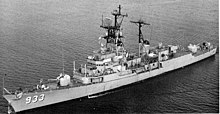Forrest Sherman class
| Forrest-Sherman class | |
|---|---|
 USS Hull (DD-945) |
|
| Overview | |
| Type | destroyer |
| units | 18 built, 0 in service |
| Namesake | Admiral Forrest P. Sherman |
| period of service |
1955 to 1988 |
| Technical specifications | |
| Information applies to the original version | |
| displacement |
4,050 ts |
| length |
127.5 meters |
| width |
13.8 meters |
| Draft |
6.7 meters |
| crew |
17 officers, 275 men |
| drive |
2 steam turbines, 2 shafts, 70,000 hp |
| speed |
32.5 knots |
| Range |
4,000 nautical miles (7,400 km) at 20 knots |
| Armament |
|
The Forrest Sherman class was a class of destroyers in the United States Navy . The 18 ships of the class were the first new destroyers built after World War II and put into service from 1955. In the mid-1960s, four ships were converted and classified as Decatur class . These had advanced air defense capabilities . Eight other ships have also been upgraded and were given as Barry class improved anti-submarine capacitances.
history
Planning and construction
Planning for the new destroyers began at the end of the 1940s, after the Mitscher-class ships (DD-927 to DD-930) originally planned as destroyers as destroyer leaders (DL), later classified as frigates , were completed after the Second World War . The development of the class falls in the pre-guided missile era, they are the last "real" artillery destroyers with ship guns as their main armament. In the planning of the ships developed from the Allen-M.-Sumner class , in contrast to the war destroyers, more attention was paid to comfort for the crew, so the accommodations were more spacious and the entire ship was air-conditioned . The construction of the ships was approved by Congress in 1953 after the first ships had been ordered from the shipyards two years earlier. The financing extended over the next three financial years.
Construction of the first unit, Forrest Sherman , began on October 27, 1953 at Bath Iron Works , and was launched on February 5, 1955. It was commissioned with the Navy on November 9, 1955. The 18th and last ship of the class, Turner Joy , launched at Puget Sound Bridge and Dredging Company on May 5, 1958 , and entered service on August 3, 1959. Other ships were built at Bethlehem Steel in Quincy , Massachusetts and Ingalls Shipbuilding . Originally seven more ships were planned (DD-952 to DD-959), but these were canceled in favor of the guided missile destroyers of the Charles F. Adams class .

Modifications
At the beginning of the 1960s it became clear that the ships with pure tube armament and outdated anti-submarine weapons no longer had any chance of defense or survival against the rapidly developing aircraft and modern submarines. In 1964 it was therefore decided to convert four ships ( DD-932 , DD-936 , DD-947 and DD-949 ) into guided missile destroyers. After a two-year stay in the shipyard, the ships were reclassified as DDG (guided missile destroyers) with the numbers 31 to 34 and put back into service as units of the Decatur class . Also in the same year the conversion of the Barry (DD-933) was approved, which received increased anti-submarine capabilities. Seven other ships were converted from 1967/68 after the Barry model. The eight ships were then run as the Barry class . The conversion of the ships cost between 14 and 17 million US dollars. The other six ships of the Forrest Sherman class were not converted due to lack of money and remained almost in their original condition until they were retired.
Whereabouts
All ships of the Forrest Sherman class and its subclasses remained in service until the early 1980s. With the Spruance-class destroyers put into service in the previous years , the Shermans had become largely superfluous, and the costs for a necessary modernization would not have paid off. Until the beginning of the 1990s, the ships remained assigned to the reserve fleet. Two ships ( Edson , Turner Joy ) have already been preserved as museum ships , the fate of the Forrest Sherman is uncertain, and a foundation is trying to save the ship currently lying in Philadelphia . All other ships were either scrapped or sunk as target ships.
technology
Hull and drive
The hull of the Shermans was 127.5 meters long and 13.8 meters wide, which roughly corresponded to the slim length-to-width ratio of 10 to 1 typical of destroyers. The draft was 6.7 meters at the hull sonar bulge. The displacement was 4,050 tons in the Forrest-Sherman and Barry classes ; the Decatur class displaced 4,150 tons due to its heavy guided missile system. The hull and superstructure were made of steel. The low superstructure, the design of which was based heavily on that of the destroyer of World War II, extended over the middle half of the hull. Behind the bridge were the two chimneys, in front of each of which a tripod mast was erected. The engine room was amidships.
The destroyers had a steam drive, the necessary steam pressure of about 80 bar was in four boilers from Foster-Wheeler ( Babcock-Wilcox boilers in DD-937, DD-943, DD-944, DD-945, DD-946 and DD-948) and then fed to two geared turbines , each of which drove a shaft with one screw each. The system's output was 70,000 hp. The maximum speed of the ships was 32.5 knots , with an oil supply of 750 tons, the ships had a range of 4,000 nautical miles at 20 knots .
Armament
General
The original main armament of all ships consisted of three Mark 42 multi-purpose guns, one in front of the bridge and two aft. Two Hedgehog launchers were located on port and starboard in front of the bridge against submarines . These were removed in the 1960s, as were the two 7.62 cm L / 50 anti-aircraft guns on double mounts that were in front of the bridge and behind the second funnel. The two double torpedo tubes Mk. 25 for submarine torpedoes behind the bridge were replaced by triple torpedo tubes as part of the modernization , the launchers for lightweight submarine torpedoes also mounted there were removed. Between 1975 and 1978, the Hull was the test platform for the 8-inch Mark 71 lightweight gun , but the program was discontinued. The Bigelow served as a test platform for the Mk. 15 Phalanx - close-in-weapon system - in the late 1970s .
Barry class
During the conversion from 1964, the ships of the Barry class received an ASROC launcher with eight cells and an automatic reload magazine in front of the launcher instead of the second gun . In addition, the ships received additional Mark 32 triple torpedo tubes including a magazine in front of the bridge on the structure of the former Hedgehog launchers and the front 76 mm gun.
Decatur class
The Decaturs received an ASROC launcher instead of the aft guns from 1964, but without a magazine, as well as a Mk. 13 single-arm launcher for anti-aircraft missiles of the RIM-24 Tartar type . These were later replaced by RIM-66 SM1 MR . The launcher had a drum magazine for 40 missiles. A spacious deckhouse made of light metal was built between the ASROC starter and the guided missile starter, on which the SPG-51 target light for the guided missiles was located.
electronics
In all versions of the Forrest Sherman-class destroyer that was as navigational radar SPS-10 from Raytheon used. Its antenna was on the front mast and was the highest antenna on board. The unmodified Shermans and Barrys also had aerial surveillance radar on the forward mast, either a SPS-37 from Westinghouse Electric Corporation or, on DD-931, -944 and -945 and DD-928, -941, -943, -948 and -950 the more modern SPS-40 from Lockheed . The Decaturs used the SPS-29E , also from Westinghouse, DDG-34 already SPS-40 for air surveillance . In addition, the 3D radar SPS-48 from ITT-Gilfillan was installed there on the aft mast . The rear light tripod mast was replaced by a heavy four-legged lattice mast.
The fire control of the 127 mm guns was carried out by means of a Mark 56 radar, the target assignment for the flak by a Mark 68, which was combined with the aerial reconnaissance radar. An SQS-23 sonar was located under the keel . The Barry (DD-933) also received a SQS-35 Independent Variable Depth Sonar for testing purposes as early as 1960 , a stern sonar with expanded and improved location and tracking capabilities.
For electronic warfare , all units had the WLR-2 or -6 system , the antennas were attached to the two masts.
commitment
The destroyers of the Forrest Sherman class were mainly designed as escort ships for aircraft carriers and as submarine hunters, but could also operate independently within a limited framework and, among other things, supported amphibious landing operations with their pipe armament. The ships of the Barry class were mostly used as submarine fighters in the aircraft carrier association, the Decaturs could operate very well independently, as they also had air defense capabilities.
The Shermans were involved in quarantine operations during the Cuba crisis . The Turner Joy was involved in the Tonkin incident , and the ships then cruised off Southeast Asia in the Vietnam War .
literature
- Stefan Terzibaschitsch : Destroyer of the US Navy . Koehlers Verlagsgesellschaft, Herford 1986, ISBN 3-7822-0395-X
- Norman Friedman: US Destroyers: An Illustrated Design History, Revised Edition . Revised edition. Naval Institute Press, Annapolis 2003, ISBN 1-55750-442-3
Web links
- Forrest Sherman class on globalsecurity.org (English)
- Forrest Sherman -class at destroyersonline.com (English)
Individual evidence
- ↑ USS Mullinix website. ( Memento from December 15, 2006 in the Internet Archive ) August 24, 2006 <(English)
- ↑ Terzibaschitsch: Destroyer of the US Navy . Koehlers Verlagsgesellschaft, Herford 1986, ISBN 3-7822-0395-X , p. 229
- ^ Terzibaschitsch: Sea power USA . Bechtermünz Verlag, Augsburg 1997, ISBN 3-86047-576-2 , page 429
- ↑ USS Mullinix What happened to them? ( Memento from August 31, 2006 in the Internet Archive ), as of August 24, 2006
- ↑ USS Mullinix Ship Specifications ( Memento December 15, 2006 in the Internet Archive ), as of August 24, 2006


